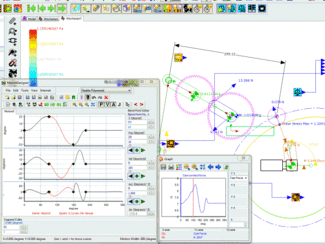
Good Cam Design improves performance.
Good Cam Design needs Cam Analysis of:
- Motion Design
- Power Transmission
Motion Design
The purpose of a cam is to impart motion, usually non-linear, to a tool that repeatedly performs some action.
Ideally, motion design should minimize impact forces, accelerations and be smooth. Motion Design greatly influences how well the cam-driven mechanism will perform. In fact, if we talk about cam design, we really mean cam system design. The cam cannot be designed in isolation. Full analysis of forces and motion is needed at all times, while you design the cam.
Motion Design
Motion Design influences many factors. Each one influences the machine performance and cam lifetime. Examples of the factors that motion design affect include:
- Machine Vibration
- Cam Contact force
- Cam Curvature
- Cam Undercutting
- Cam Pressure Angle
Power Transmission
The mechanism that transmits power between the tool and the cam profile greatly influences cam lifetime.
- Roller Diameter: maximum shear stress: roller lifetime
- Centre positions and link lengths: Pressure Angle: contact force

